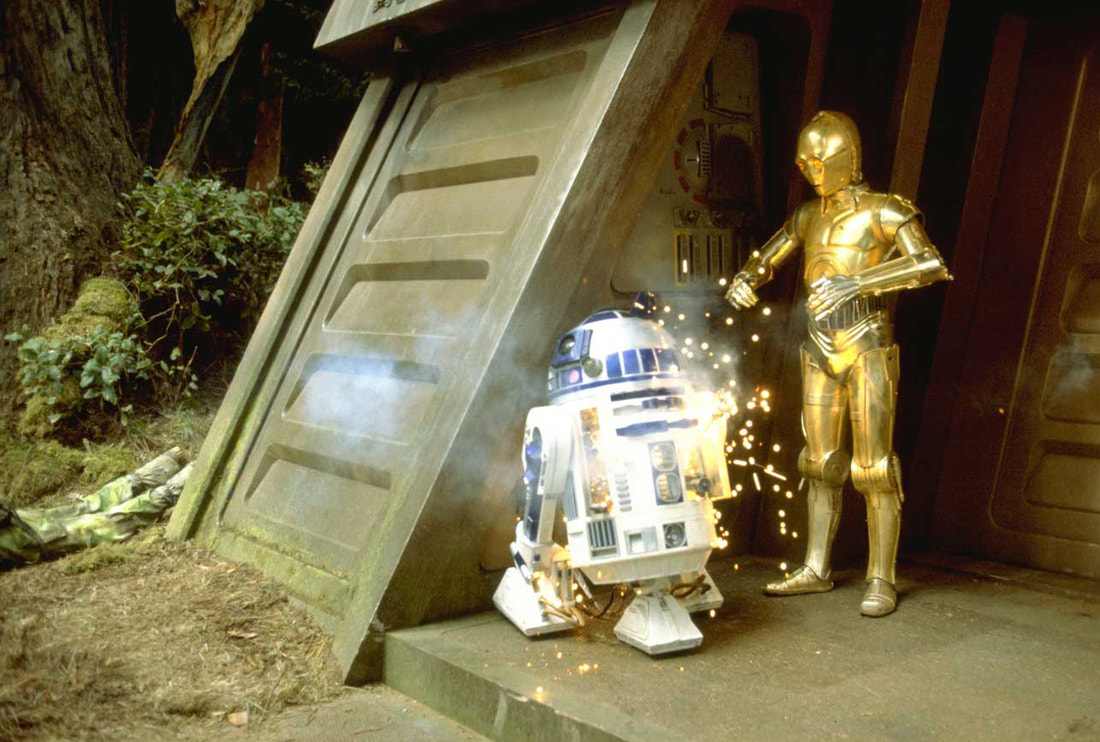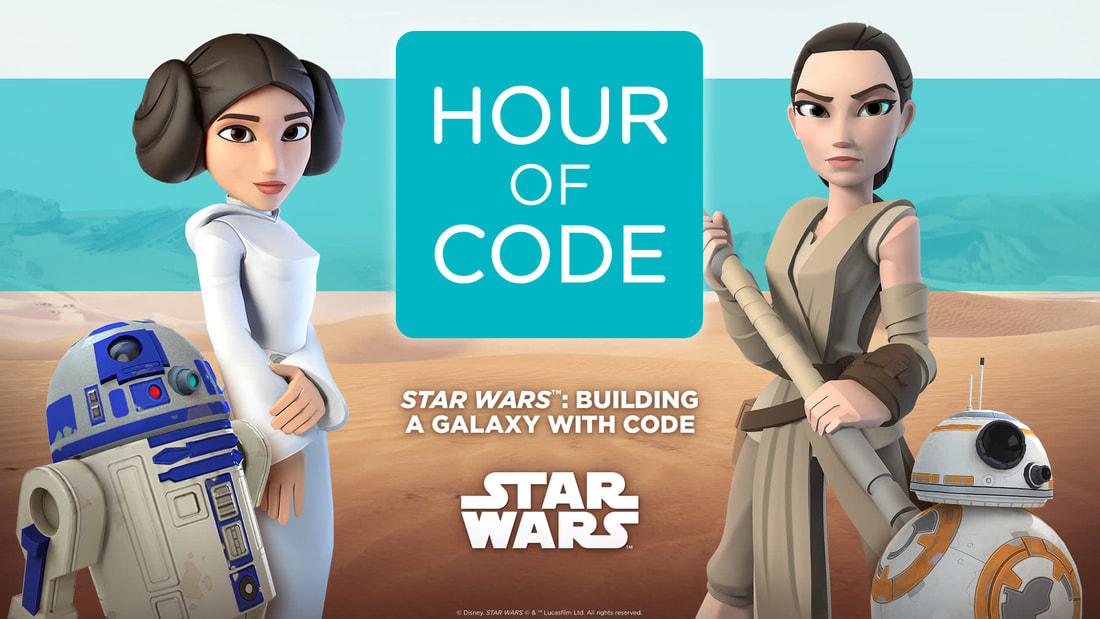A brief introduction to my new project Artoo Detoo and See Threepio on Endor: one of my earliest memories of Star Wars Artoo Detoo and See Threepio on Endor: one of my earliest memories of Star Wars My earliest memory of Star Wars is in many ways unspectacular and ordinary. A VHS copy of Return of the Jedi (1983) is playing on a small, 13” TV set in the corner of the room. I’m not sure what I’m paying attention to but it isn’t the film. Lego, perhaps, or the Barbie doll that lives in a Cindy house. Something is going on to divert my attention away from the screen. Yet suddenly, at least in my memory of the experience, I become aware of Star Wars. Amid the dense forest of onscreen trees, rebel fighter Princess Leia (Carrie Fisher) appears before me and fires a blaster pistol shot of laser-blue energy at the approaching enemy forces of the Imperial Army. The metallic figures of droids R2-D2 (Artoo; Kenny Baker) and C-3PO (Threepio; Anthony Daniels) attempt to open the imposing concrete door of something called a shield generator. And hero Luke Skywalker (Mark Hamill) draws on his Jedi faith to duel with a terrifying figure clad in black armour using a sword that looks like an electric neon light stolen from a fairground. It is exciting and entrancing… and a little confusing. Confusing because to my young eyes, nothing about Star Wars makes sense. Dropped as I am into the middle of the third film in a trilogy, I cannot understand the narrative. The film’s highly polished robots are incongruous in a world inhabited by spear-wielding teddy-bears (Ewoks), and the futuristic AT-ST armoured vehicles and 74-Z speeder bikes seem out of place in the natural forest-scape represented on screen. The rapid dialogue between the human actors is also bewildering to ears untrained in the language of the Star Wars series (Artoo and the Ewoks, who do not speak English, will remain my favourite characters for almost a decade). But none of this ambiguity matters. Because no matter how complicated the story seems, or indeed how complicated the franchise becomes in its expansion over the next three decades, I will consume films, games and other screen media; visit online fan sites; experience theme-park rides; read print material such as atlases and novels; and buy merchandise including my beloved Artoo and Ewok t-shirts. I am immediately a Star Wars fan. Now, though, I am also a scholar, who, equipped with my own armoury of media history and theory, has watched the Star Wars original trilogy (Episodes IV-VI) more times than I can accurately estimate and the prequels (Episodes I-III), sequels (VII-IX), and canonical spin-offs on multiple occasions, too. In doing so, I have recognised that while there is an overwhelming array of texts through which the universe is constructed, and more interwoven transmedia narratives than I can ever hope to comprehend, there is a single, unifying logic to the franchise. Star Wars is fundamentally about code. It is about analogue and digital codes created by humans and applied by machines in the films’ production and exhibition, and the changing codes and conventions of Hollywood cinema. It is about genetic codes and inherited traits passed between the Skywalker family members, and codes that mutate and become infected by virus-like external forces. It is about Jedi codes of honour and the exchange of codes between characters on screen. It is about linguistic codes that circulate among fans to demonstrate their knowledge of the universe’s planets, technologies, and alien life forms. It is about the barcodes and QR-codes that populate cinemas and stores and theme parks selling material encounters with the franchise. And it is about the economic coding systems that enable consumers to buy Star Wars products, as well as the numerical codes bought by the Rebel Alliance to circumvent Imperial security systems in Return of the Jedi. Everything in Star Wars, from the mysteries of the Force to the films’ theatrical distribution and exhibition, can be explained through its relationship to, and dependence on, code. The Star Wars franchise, I argue, is a constellation of different yet intersecting analogue and digital codes that represent the infrastructures of our everyday environments. The matrices of codes that appear in the movies are similar to those that people (at least those with certain levels of privilege) encounter in their daily lives, for example, through using smart phones, accessing the Internet, and streaming audiovisual media online. From representations of archived databases to computer surveillance networks, Star Wars exposes the usually hidden systems of technological communication that mediate our interactions with both the physical and virtual (although no less material) world. Throughout the project, I explore how code underpins the films’ production, aesthetics, and exhibition via CGI, onscreen representation, and the digitisation of media formats and modes of distribution. I propose that Star Wars media offer a solution to the problem of ‘backgrounding’ that Adrian Mackenzie identifies in his work on software (2015). Mackenzie argues that computer code has a ‘fringe existence’ in mainstream culture because it is both difficult to represent and mysterious to non-experts. However, Star Wars depicts the evolution of technology from the basic guidance systems used in A New Hope in 1977 to the portable, wireless tablets that appear in The Phantom Menace in 1999. The franchise foregrounds the processes of programming that are largely invisible to us even in our physical interactions with computer technologies. My project also aims to explore the material intersections of cinema and coding via production histories focusing on the labour of programmers and creative talent at Lucasfilm, Industrial Light and Magic, and Disney. Drawing on the work of Safiya Umoja Noble (2018), the project will examine the ideologically complex systems of power that influence who writes code, who code is written for, and how people engage with code in the film industries. I contend that Star Wars does not just tell us what code is and what it does, but also how its applications and circulations are circumscribed and contested in a capitalist culture that privileges patriarchy, whiteness and heteronormativity. Star Wars media, then, including TV shows, games and VR experiences, arrange audiovisual codes in a densely circuited system that simultaneously sets up interwoven narratives on screen, while also recalling the media’s own means of production. The franchise may refer to stories that occurred in a distant galaxy and a different age, but the types of code that underpin the onscreen universe are recognisable as those that organise our own world via film language and analogue and digital computing. Consequently, it reflects changes in our experiences and perceptions of code from 1977 to the present day. Moreover, Star Wars invites us to look beyond the surfaces of the media that we watch, touch, swipe, and scroll to the invisible formations of binary code that are backgrounded beneath the screen. In doing so, the films, for example, entice viewers into archives of code that are layered within transformed, and always transforming, stacks of analogue and digital imagery. Now variously as a scholar, historian, and explorer of software—but always (always) as the fan that as a child questioned the codes and conventions of the Star Wars universe—I aim to open up and examine its archive. What will follow in my new project, therefore, is my decoding of a series that has fascinated me for nearly three decades – a fascination that all began with a line about transmitting code for clearance to land on a forest moon a long time ago in a galaxy far, far away.
7 Comments
27/6/2023 09:57:40 am
Thanks for sharing a very informative and knowledgeable blog I like it.
Reply
5/6/2024 10:23:05 am
Your appreciation means a lot! It's like putting together a puzzle—finding the perfect word is like finding that missing piece that completes the picture of your writing. Keep practicing, and you'll definitely see progress!
Reply
Leave a Reply. |
BlogArchives
November 2018
Categories
All
|

 RSS Feed
RSS Feed